|
What a year this has been for the Mars Odyssey team!
The excitement of launch last April 7, the arrival at Mars, the long,
sometimes tedious aerobraking concluded so successfully, the beginning
of the mapping phase ....
The detailed pictures the camera system is taking, letting scientists
get closer and closer to Mars' mysteries ....
The evidence from the gamma ray spectrometer showing more
hydrogen in Mars' southern hemisphere than was known before ....
The drama of the martian radiation environment experiment - as it
turned out, the instrument was just taking a long nap ....
Anniversary Toasts From the Odyssey Team
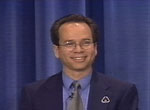 |
Roger Gibbs
|
"We have an A-plus spacecraft," said Roger Gibbs,
Odyssey project manager at NASA's Jet Propulsion Laboratory.
"Everything is going smoothly and we're looking forward to
another great year."
 |
| Bob Berry |
Bob Berry, Lockheed Martin Astronautics Odyssey program
manager, said, "The performance of the spacecraft and the
spacecraft team has been virtually flawless during cruise, orbit
insertion and aerobraking. Now it's payoff time and we're ecstatic to
finally start seeing the fruits of our labor - great science."
He added, "Early results are amazing and the team is
looking forward to Odyssey adding another chapter in our Mars
book of knowledge."
Still early in the mapping mission, Odyssey has already begun to
return surprising new views of the red planet.
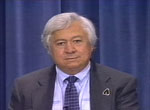 |
| Dr. Steve Saunders |
"Odyssey's unique instrument set is working nearly
perfectly," said JPL's Odyssey project scientist Dr. Steve
Saunders. "We are getting new insights into the physical and
chemical makeup of Mars."
 |
Dr. Phil Christensen
|
Camera system principal investigator Dr. Phil Christensen, Arizona
State University, Tempe, said, "We now have night vision on Mars
and have acquired images taken in complete darkness on the planet. The
daytime images help scientists map minerals and study safe places for
future Mars landings.
A new Mars image is posted daily by Christensen's team. To see the
images, go to http://themis.asu.edu/latest.html .
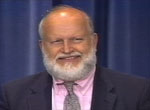 |
Dr. Bill Boynton
|
Dr. Bill Boynton, University of Arizona, Tucson, the gamma ray
spectrometer scientist and team leader, said, "We can see a
strong hydrogen signature in Mars' southern hemisphere, even without
boom deployment [scheduled for May]. There's a lot of water there."
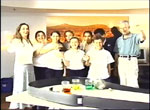 |
Dr. Bill Feldman (far right), Heather Enos (far left)
|
Neutron spectrometer scientist Dr. Bill Feldman, Los Alamos
National Laboratory, New Mexico, agreed and said, "We're finding
a lot of water ice in the soil of Mars."
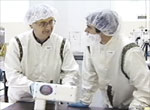 |
| Dr. Igor Mitrofanov |
Rounding out the gamma ray spectrometer team is Dr. Igor
Mitrofanov, principal investigator for the Russian high energy neutron detector.
He said, "A vast area of permafrost has been discovered
in the southern hemisphere and we start to see the northern
permafrost as well in high energy neutrons."
More information, including links, about the gamma ray
spectrometer suite of instruments is available at http://grs.lpl.arizona.edu/ .
The martian radiation instrument did not communicate for about
six months, but after extensive troubleshooting is now "talking"
with scientists again. The experiment measures radiation that could
endanger humans and provides a check on overall radiation that might
affect other Odyssey instruments.
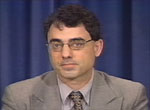 |
| Dr. Frank Cucinotta |
"This experiment is important for any future human exploration
of Mars," said principal investigator Dr. Frank Cucinotta, NASA
Johnson Space Center, Houston, Texas.
http://marie.jsc.nasa.gov/
has more information on the radiation instrument.
|